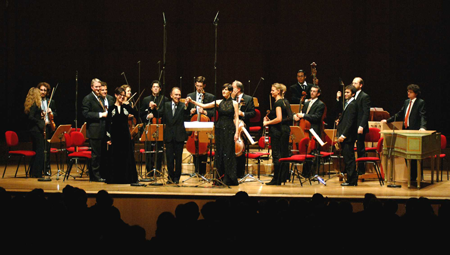11 Nov 2007
Preparing G.B. Pergolesi’s tercentenary — with a fair advance
A notice for organizers: it’s relatively easy to produce a vocal recital and sell out a large house for two nights in a row.

A notice for organizers: it’s relatively easy to produce a vocal recital and sell out a large house for two nights in a row.
All you need is three (good) singers and a youth orchestra that, with a bit of a squeeze, can be fitted into an estate car. Plus, of course, a starry conductor, a living myth whose very presence on the podium is enough to make news. After several cancellations due to his state of health, old glory Claudio Abbado is back again from a convalescence of two months in sunny Sardinia, apparently in good shape and in a relaxed state of mind. On November 6-7, at Bologna’s Teatro Manzoni, he led an all-Pergolesi recital inaugurating the extended celebrations for the birth tercentenary of the ‘Neapolitan’ master, who actually saw the light of day on Jan 4, 1710, rather far from the Vesuvius: in Jesi by Ancona, then a part of the Papal States and a hot district for opera. In fact, motors of the venture are the Jesi-based ‘Fondazione Pergolesi Spontini’ (thus named for both composers, who were born only a few miles apart) and Bologna’s Orchestra Mozart, since 2004 Abbado’s pet creature.
Halfway between chamber and symphony ensemble, the Orchestra Mozart includes some forty instrumentalists aged 17-25, plus five experienced principals. A selection of 17 players — budding professionals from several countries who are still practising, with some residual degree of compromise as to strings and bows, on period instruments — tackled the Concerto in B flat for violin, strings and continuo, one among the handful of instrumental works whose Pergolesi authorship has been validated by recent research. Curiously, it’s written in a Venetian style closely resembling Vivaldi’s; so Giuliano Carmignola, the concert master who ranks as a specialist in the field, sounded quite at ease in his most familiar territory, despite a venial slip at the very start.
Until this point, Abbado kept a non-committal attitude, mostly mirroring Carmignola’s tempo choices with smiling nods and subtle gestures that seemed to highlight the structural framework just for the audience’s benefit. He definitely took the lead in the following Salve Regina, featuring soprano Julia Kleiter in the solo part. Though not an adept of flamboyant singing, Kleiter commands crystal-clear uttering, fine legato, sensitive dynamic, precise intonation even in treacherous chromatic passages (such as those found at ‘misericordes oculos’). Her weak point resides in the passage to the upper register, ending in explosive high notes after a transient black hole.

Two terrific primadonnas then stepped in for the celebrated Stabat Mater: soprano Rachel Harnisch and alto Sara Mingardo. Widely diverse in their looks, the skinny, nervous Austrian brunette and the motherly Italian newly donning henna-colored hairdoes and professoral spectacles, share panache, deep understanding of the sung text and sophisticated technical strokes. Harnisch, notable for her sustained clarion tones throughout, ignited trills and downward appoggiaturas of penetrating dramatic strength, such as in the famed ‘pertransivit gladius’. Mingardo deployed her bronze-polished centers in all their might, stretching down without apparent effort to cavernous bassoon-like notes and then soaring backward to the highest peaks. (A non-written cadenza in ‘Fac ut portem Christi mortem’ was particularly astonishing to that respect).
Without ever stealing the show, Abbado kept the primadonnas together in strict duo textures, while launching vigorous contrapuntal sections with his typical blend of passion and clarity, all in the right places. The final chord in the ‘Amen’ fugue plunged the spellbound hall into silence for a seemingly endless while. Ovations, stamping and (unfulfilled) calls for encores ensued. Yet, after a moment of such perfection, little could be added to the experience.
Carlo Vitali